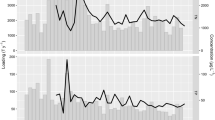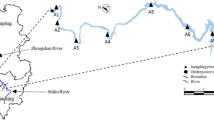Abstract
The lake phytoplankton community model, PROTECH includes nested regression equations for the effect of surface:volume ratio, temperature and irradiance on growth rate. A sensitivity analysis was carried out of the effect of changing the regression slope coefficients on three aspects of the simulated output for Blelham Tarn, English Lake District, with fixed environmental variables. The assessed variables were K, the maximum biomass; K, time taken in days to reach K and the exponential growth rate, r'. It was found that the light adjustment equation was the most sensitive to changes in the slope parameters. Changes in the base growth rate and temperature adjustment functions had less effect. Because PROTECH uses the light adjustment equation the least, it was argued that any error caused by it was tolerable.
Similar content being viewed by others
References
Elliott, J. A., C. S. Reynolds, A. E. Irish & P. Tett, 1999. Exploring the potential of the PROTECH model to investigate phytoplankton community theory. Hydrobiologia 414: 37–43.
F. B. A., 1989. The FBA-Welsh Water simulation model of phytoplankton dynamics in a flushed system - authentication in a coastal lagoon. Freshwat. Biol. Assoc., Ambleside. (Cyclostyled). 51
Hilton, J., A. E. Irish & C. S. Reynolds, 1992. Active reservoir management: a model solution. In Sutcliffe, D. W. & J. G. Jones (eds), Eutrophication: Research and Application to Water Supply. Freshwat. Biol. Assoc., Ambleside: 185–92.
Howard, A. (ed.), 1997. Algal Modelling: Processes & Management. Hydrobiologia 349.
I. F. E., 1993. Annual Report of the Institute of Freshwater Ecology. Nat. Envir. Res. Council, Swindon.
Jørgensen, S.E., 1995. State of the art of ecological modelling in limnology. Ecol. Model. 78: 101–115.
Reynolds, C. S., 1989. Physical determinants of phytoplankton succession. In Sommer, U. (ed.), Plankton Ecology. Brock-Springer, Madison.
Reynolds, C. S., 1996. The threat of algal blooms in proposed estuarine barrages: models, predictions, risks. In Burt, N. & J. Watts (eds), Barrages: Engineering and Environmental Impacts. John Wiley, Chichester: 83–89.
Reynolds, C. S., 1999. Modelling phytoplankton dynamics and its application to lake management. In Harper, D. M., B. Brierley, A. J. D. Ferguson & G. Phillips (eds), The Ecological Bases for Lake and Reservoir Management. Developments in Hydrobiology 136. Kluwer Academic Publishers, Dordrecht: 123–131. Reprinted from Hydrobiologia 395/396.
Reynolds, C. S. & Irish, A. E. 1997. Modelling phytoplankton dynamics in lakes and reservoirs: the problems of in-situ growth rates. Hydrobiologia 349: 5–17.
Whitehead, P. G. & G. M. Hornberger, 1984. Modelling algal behaviour in the river Thames. Wat. Res. 18: 945–953.
Author information
Authors and Affiliations
Rights and permissions
About this article
Cite this article
Elliott, J.A., Irish, A.E., Reynolds, C.S. et al. Sensitivity analysis of PROTECH, a new approach in phytoplankton modelling. Hydrobiologia 414, 45–51 (1999). https://doi.org/10.1023/A:1003845202692
Issue Date:
DOI: https://doi.org/10.1023/A:1003845202692




